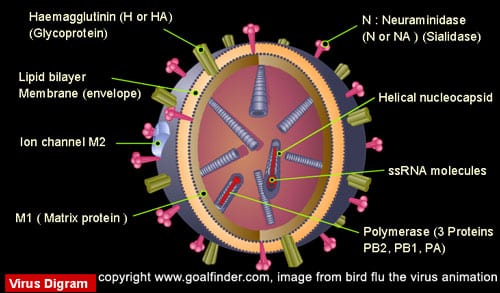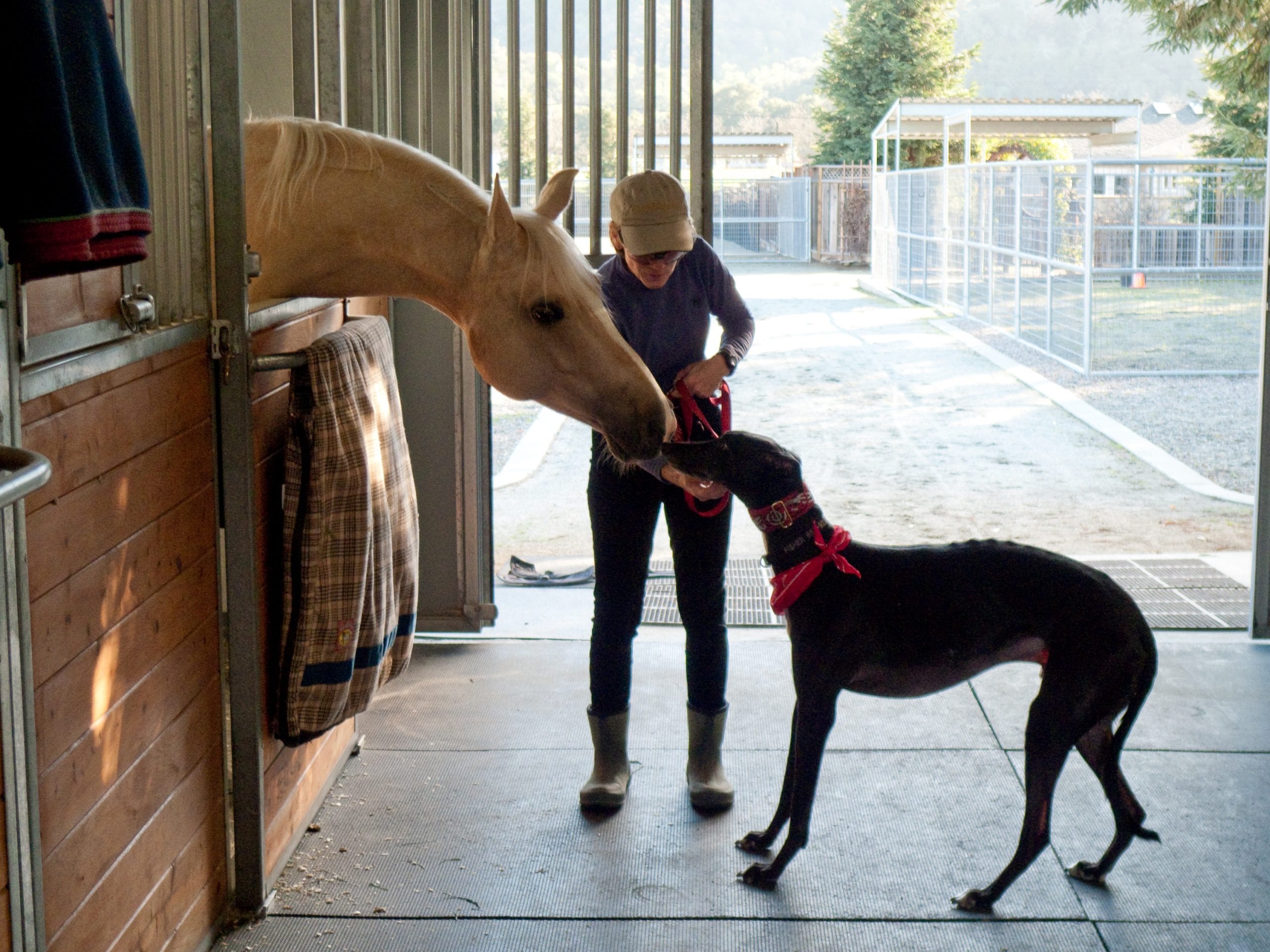Seriously, don't come to work if you're sick. How many times have we all heard this mantra? When people bring their infectious illness to work, it spreads like wildfire. Especially in the case of influenza (flu), a sick person can spread their tiny infectious droplets to other people up to 6 feet away.
The same thing can happen with your dog.
Influenza is a viral disease that has a long history of affecting birds and other mammals, but was only recently recognized in dogs. Canine influenza, or dog flu, is a highly contagious respiratory disease caused by specific Type A influenza viruses known to infect dogs.
Influenza A viruses are divided into subtypes based on two proteins on the surface of the virus: hemagglutinin (HA) and neuraminidase (NA). Many different combinations of HA and NA proteins are possible, and wading through the alphabet soup of influenza subtypes can be a dizzying task. More on this in my next blog.

For now, let's focus on the story of two influenza subtypes, H3N8 and H3N2, and their links to canine influenza in the U.S.
In January 2004, the first evidence of an Influenza A virus causing disease in dogs was reported. An equine influenza A virus subtype H3N8 caused a respiratory illness at a Greyhound race in Florida. This subtype is closely related to the virus that causes equine influenza, and it is thought that the equine influenza virus mutated to produce the canine subtype. This canine subtype of H3N8 has now affected dogs in ~ 40 states.

Fast-forward to 2015, an avian influenza A virus subtype H3N2 was identified following an outbreak of respiratory illness in dogs in the Chicago area. Prior to this report in the U.S., the H3N2 virus had been documented in Korea, China and Thailand; but not outside of those countries.
We can connect the dots and see that the outbreak in Chicago suggests a recent introduction of the H3N2 virus from Asia. This H3N2 subtype is believed to have resulted from the direct transfer of an avian influenza virus circulating in live bird markets to dogs. And voilà , it has now been confirmed that the Chicago canine influenza outbreak was caused by an H3N2 subtype that was almost genetically identical to the one found in Asia.
Since 2015, thousands of dogs have been confirmed positive for the H3N2 canine influenza virus across the U.S.. According to the Canine Influenza Virus Surveillance Network, from March 2015 to present there have been about 600 positive cases of H3N2 influenza virus in Georgia alone.
So here is the important question, are all dogs at risk of getting canine influenza?
The short answer is yes. Since this is an emerging disease and dogs in the U.S. have not been exposed to it before, almost all dogs lack immunity to it and are susceptible to infection. The American Veterinary Medical Association notes that virtually all dogs exposed to the virus become infected, and nearly 80% show clinical signs of disease. The signs of illness in dogs are cough, runny nose, fever, lethargy, and reduced appetite, but not all dogs will show symptoms.

The risk of any dog being exposed to canine influenza virus depends heavily on lifestyle choices. Dogs that are frequently socializing with other dogs at boarding kennels, dog parks, grooming salons etc. are at greater risk of coming into contact with the virus. It is spread by direct contact with respiratory secretions from infected dogs, meaning by barking, coughing, or sneezing, and by contact with contaminated objects.
Also, just like in people, extra precautions should be taken with puppies, elderly, or pregnant dogs since these dogs do not have the ability to respond normally to an infection due to an impaired or weakened immune system. Interestingly though, a recent article estimated that dogs infected with the H3N2 subtype produce about 100 times more of this virus than H3N8 canine influenza, and for a much longer period of time. Generally dogs are free of the virus 1 week after symptoms appear, but with this particular H3N2 subtype, the virus may shed up to 3 weeks or more after symptoms have resolved. These findings are extremely important for implementing changes in quarantine protocols.
So how do you reduce the risk of your dog getting dog flu? Lucky for you, I have an answer! Prevention is the best cure. Get your dog vaccinated and use good infection control practices. Dogs with canine influenza should be isolated to prevent transmission of the virus to other dogs or, in the case of H3N2, cats.
Can you catch flu from fido? No, you are in the clear. To date, there is no evidence of transmission of canine influenza viruses from dogs to people and there have been no reported human infections with canine influenza viruses. Despite this fact, it is important to keep in mind that influenza viruses are constantly evolving. While both canine influenza subtypes are of concern, the infectivity of the H3N2 subtype raises questions about the interspecies transmission of avian influenza viruses and adaptation of these viruses to canine physiology.
Next in this series, we will focus our discussion on the fascinating capabilities of influenza A viruses to do more with less. These viruses have highly sophisticated genetic material and replication cycles that allow them to undergo both small genetic changes and abrupt, major changes, termed as “antigenic drift†and “antigenic shiftâ€, respectively. Then, we will move our focus to dog flu vaccines and how they work.
 Lydia Anderson is a Dual DVM-PhD graduate student at the University of Georgia. Since completing her PhD in Infectious Diseases, she has been working on her DVM at the College of Veterinary Medicine with an emphasis in public health and translational medicine. She plans to use her training to help address the questions and challenges facing One Health due to emerging and zoonotic infectious diseases. When she is not busy learning how to save all things furry and playing with test tubes, Lydia can be found either freestyle cooking for her friends and family or binge watching Netflix with her rescue pup, Luna. More from Lydia Anderson.
Lydia Anderson is a Dual DVM-PhD graduate student at the University of Georgia. Since completing her PhD in Infectious Diseases, she has been working on her DVM at the College of Veterinary Medicine with an emphasis in public health and translational medicine. She plans to use her training to help address the questions and challenges facing One Health due to emerging and zoonotic infectious diseases. When she is not busy learning how to save all things furry and playing with test tubes, Lydia can be found either freestyle cooking for her friends and family or binge watching Netflix with her rescue pup, Luna. More from Lydia Anderson.
About the Author
- athenssciencecafehttps://athensscienceobserver.com/author/athenssciencecafe/April 17, 2020
- athenssciencecafehttps://athensscienceobserver.com/author/athenssciencecafe/April 12, 2020
- athenssciencecafehttps://athensscienceobserver.com/author/athenssciencecafe/April 3, 2020
- athenssciencecafehttps://athensscienceobserver.com/author/athenssciencecafe/March 30, 2020







